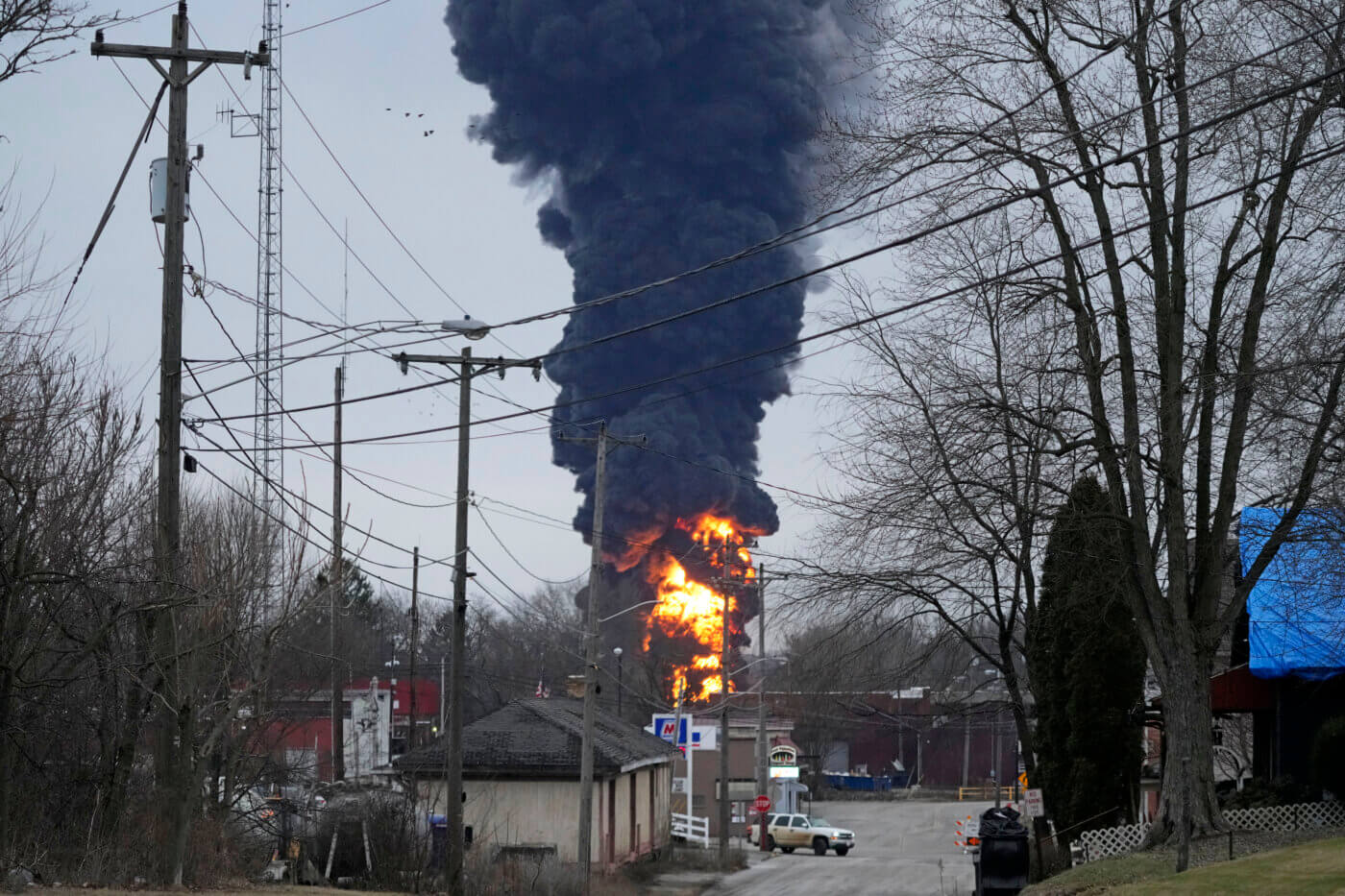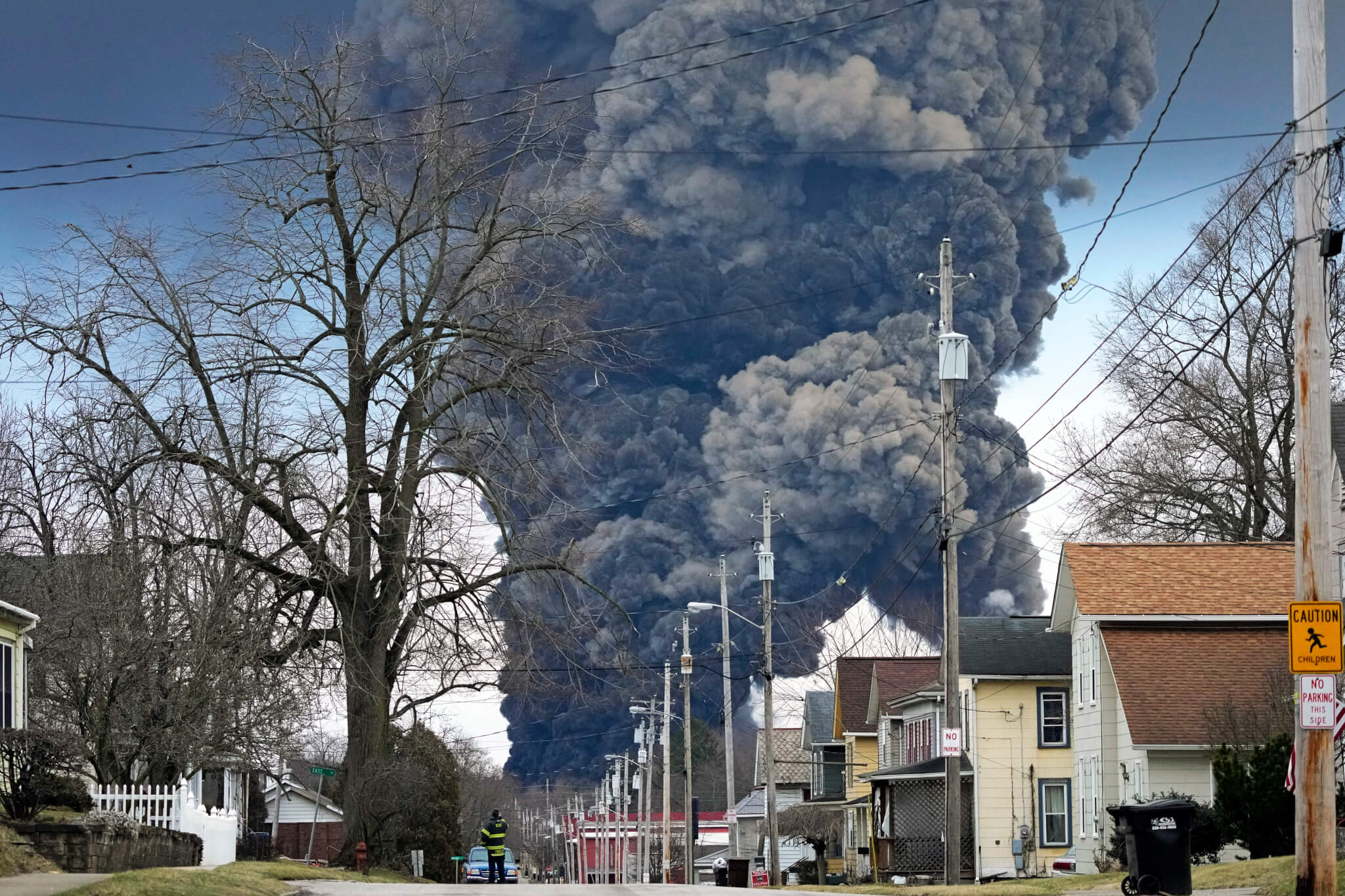
A black plume rises over East Palestine, Ohio, as a result of a controlled detonation of a portion of the derailed Norfolk Southern Monday, Feb. 6, 2023. (AP Photo/Gene J. Puskar)
Gov. Josh Shapiro sent a letter to Norfolk Southern expressing serious concerns about the railroad company’s response to a 50-car train derailment and subsequent burning of hazardous chemicals.
It’s been more than a week since a fiery train derailment and subsequent burning of hazardous chemicals in Ohio, just a quarter-mile from the Pennsylvania state line, and many are still concerned about potential air and water contamination. Chief among them is Gov. Josh Shapiro, who is placing the blame on railway company Norfolk Southern.
In a letter to Norfolk CEO Alan Shaw, Shapiro said he has serious concerns about the way the train company handled the 50-car derailment in East Palestine, Ohio on Feb. 3. While no one was injured in the wreck — which happened because of a mechanical issue with a rail car axle — the surrounding area had to be evacuated due to fears of a potential explosion from the hazardous chemicals on board the train. Beaver County was among the areas evacuated.
Officials seeking to avoid the danger of an uncontrolled blast chose to intentionally release and burn toxic vinyl chloride from five rail cars, sending flames and black smoke again billowing high into the sky. The jarring scene left people questioning the potential health impacts for residents in the area and beyond, even as authorities maintained they were doing their best to protect people.
Shapiro accused Norfolk of mismanaging the disaster from the outset, citing the company’s failure to immediately notify the Pennsylvania Department of Environmental Protection and the Pennsylvania Emergency Management Agency. Norfolk’s actions, he said, hampered the response from local and state agencies, and put residents and first responders at serious risk. Shapiro also said the company had been unwilling to look at alternatives to intentionally releasing and burning the five cars filled with vinyl chloride.
“While I appreciate that responding to train derailments presents an array of complex challenges, failure to adhere to well-accepted standards related to practice of incident management and prioritizing an accelerated and arbitrary timeline to reopen the rail line injected unnecessary risk and created confusion in the process,” Shapiro said. “You can be assured that Pennsylvania will hold Norfolk Southern accountable for any and all impacts to our commonwealth.”
For Ohio and Pennsylvania residents impacted by the train derailment and subsequent burning of some of the hazardous chemicals, questions remain:
Was the Controlled Burn Safe?
Vinyl chloride is associated with increased risk of certain cancers, and officials at the time warned burning it would release two concerning gasses — hydrogen chloride and phosgene, the latter of which was used as a weapon in World War I.
Environmental officials say that monitors detected toxins in the air at the site during the controlled burn and that officials kept people away until that dissipated. They say continuing air monitoring done for the railroad and by government agencies — including testing inside nearly 400 homes — hasn’t detected dangerous levels in the area since residents were allowed to return. The US Environmental Protection Agency has shared air monitoring results online.
What are the Continuing Concerns?
Some residents say they worry about long-term effects of even low-grade exposure to contaminants from the site.
The risk to animals is low, according to the Ohio Department of Agriculture, which recommended that people contact a local veterinarian for any concerns about their livestock or pets’ health. The department hasn’t received any official reports about livestock or pet illnesses or deaths directly related to the incident, though making such a determination would require a necropsy and lab work, ODA said.
Ohio Health Department Director Bruce Vanderhoff cautioned at a news conference Tuesday that residents who were worried about lingering odors or headaches since the derailment should know that those can be triggered by contaminant levels in the air that are well below what’s unsafe.
The derailment also highlighted questions about railroad safety, though federal data show accidents involving hazardous materials at this scale are very rare. Trains were rolling past East Palestine again soon after the evacuation order was lifted.
What About Water Contamination?
Contaminants from derailed cars spilled into some waterways and were toxic to fish, but officials have said drinking water in the area has remained protected.
In addition to vinyl chloride, at least three other substances — butyl acrylate, ethylhexyl acrylate, and ethylene glycol monobutyl ether — were released into the air, soil or water, according to a EPA letter putting Norfolk on notice about its potential liability for cleanup costs.
Norfolk’s response has included efforts to remove spilled contaminants from the ground surface and nearby streams, as well as air quality monitoring, soil sampling and residential water well surveys.
The contaminant amounts found so far don’t pose a risk for cities that rely on the river for its drinking water, the Ohio EPA said.
In response, some water companies have shut off their intakes or increased treatment processes as a precaution.
Information from the Associated Press was used in this story.
Politics

Biden announces tariffs on Chinese Steel while visiting United Steelworkers members
“I'm president because of you guys. I really am and I'm proud. As was mentioned earlier, I'm proud to be the most pro-union president in American...

Opinion: Is Reproductive Healthcare just a women’s issue?
In this op-ed, Pennsylvania resident Lynn Strauss discusses the Republican Party’s conflicting stance on reproductive healthcare policy and the...

2 top US gun parts makers agree to temporarily halt sales in Pennsylvania
Philadelphia filed suit against Polymer80 and JSD Supply last year, accusing the manufacturers of perpetuating gun violence by manufacturing ghost...
Local News

Conjoined twins from Berks County die at age 62
Conjoined twins Lori and George Schappell, who pursued separate careers, interests and relationships during lives that defied medical expectations,...

Railroad agrees to $600 million settlement for fiery Ohio derailment, residents fear it’s not enough
Norfolk Southern has agreed to pay $600 million in a class-action lawsuit settlement for a fiery train derailment in February 2023 in eastern Ohio,...






